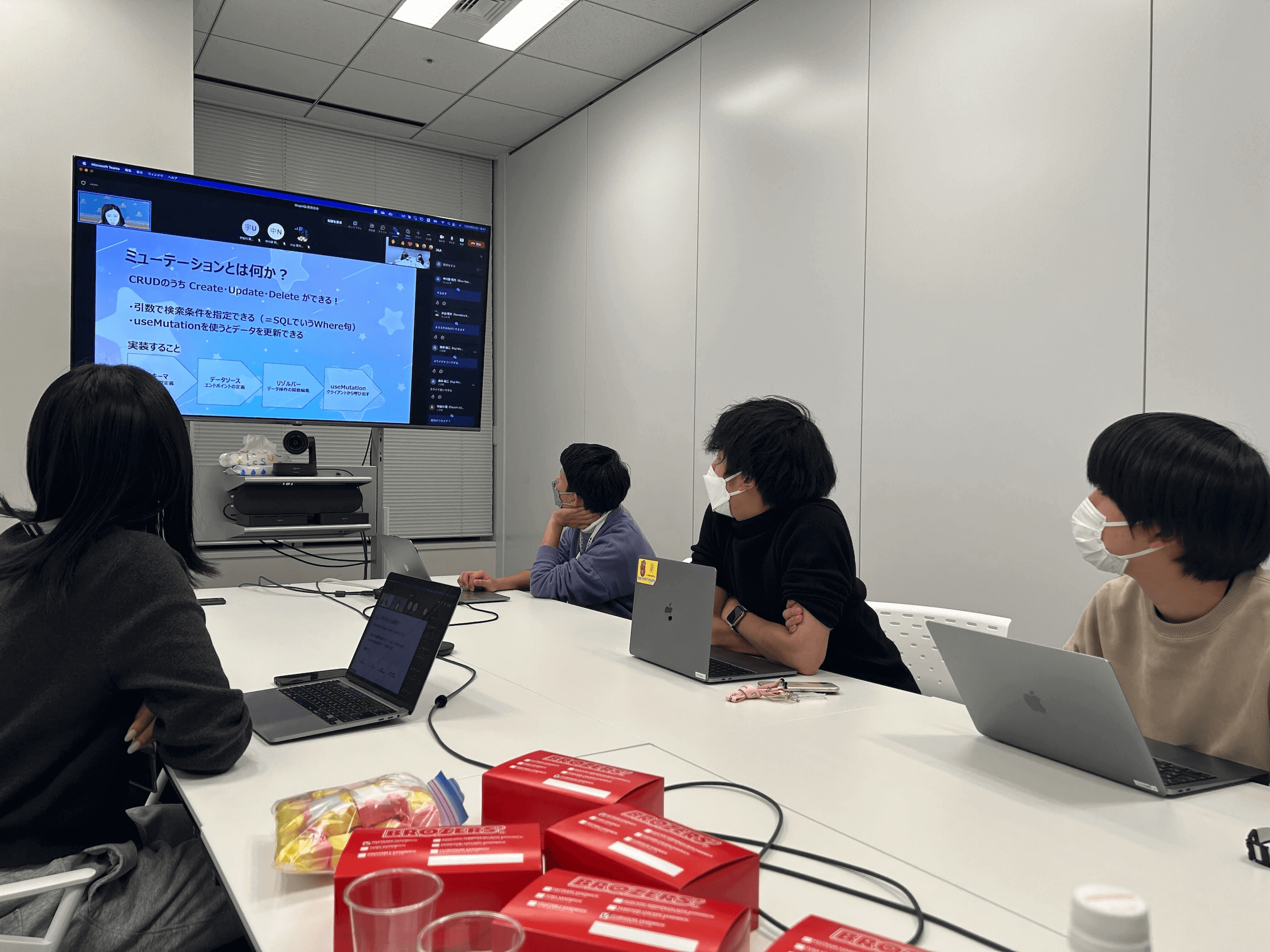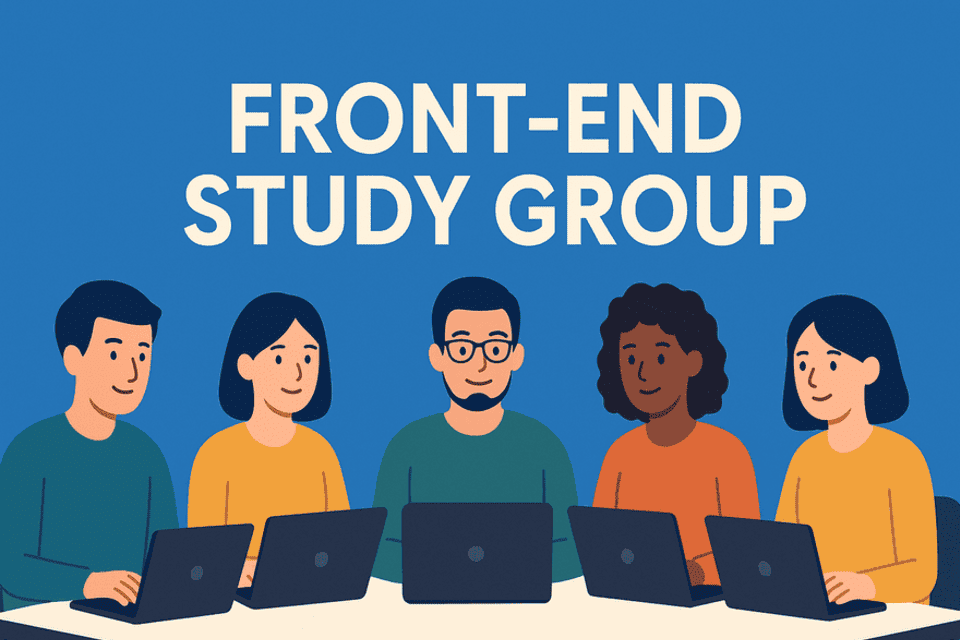若手メンバーでGraphQLについて勉強会をしてみた

はじめに
こんにちは。KINTOテクノロジーズでバックエンドを担当している森本です。
KINTO ONE開発グループに所属しています。Javaをメインに利用してKINTO ONEの開発をしています。今回は業務とは別に実施しているGraphQLの勉強会について紹介させていただきます。
GraphQLとは
GraphQLとはクエリ言語の一つです。SQLのような他の言語とは異なり、特定のデータストアに限らず複数のデータソースとデータをやりとりすることができます。
バックエンド側でスキーマを定義しておけば、フロントエンド側はその定義に従って自由にオブジェクト内の項目を取得することができます。REST APIとは異なり、フロントエンドがバックエンドから返却してほしい情報を柔軟に指定できます。利用しない情報を無駄に取得する必要がなくなり、またネスト構造になっているオブジェクトを取得するために複数回APIを呼ぶ必要もなくなります。
勉強会の目的
勉強会の目的は以下の2つです。
- 技術力をアップしたい
- グループを超えて交流したい
技術力をアップしたい
普段の業務で利用している技術とは別に新しい情報をキャッチアップしたいが、ハードルが高いとメンバーそれぞれが感じていました。例えば言語の知識が足りないことが挙げられます。今回のGraphQLのチュートリアルではTypeScriptが利用されていました。そのため、GraphQLを学ぶ前にまずTypeScriptを学ぶ必要がありました。知識や経験が異なるもの同士で補うことで、このような課題をクリアして学習のコストを下げることができます。
グループを超えて交流したい
所属するグループ、チーム、プロジェクトがそれぞれ異なる年齢の近いメンバー同士が交流するきっかけにしたいという思いもありました。既にお互いを認知している仲の良いメンバー同士ではありますが、定期的に集まることでより仲良くなろうという魂胆です。また勉強会を通してお互いの持っている新たな一面を知ることができる機会になるとも考えました。
実施内容
なぜGraphQLか
バックエンドでAPIを普段実装しているメンバーは、要件が発生するたびAPIを作成する必要があることに悩みを抱えていました。もちろんサーバー側で処理を行った方が実行速度が速いものはありますが、情報をそのまま返却するAPIを増やしていくのは面倒だと感じていました。そこでGraphQLが解決策として良さそうだという話を聞き、ぜひ試したいと常々思っていました。
また既にGraphQLを利用したことがあるメンバーもいましたが、全体の処理の流れを把握したいという思いがあり、GraphQLを学習することにしました。
勉強会に利用したチュートリアル
GraphQLのライブラリにはApollo GraphQLを選び、チュートリアルは以下リンク先のものを使用しました。
理由としては、チュートリアルの量が充実しており、入門編として適切だと感じたためです。また勉強会メンバー内に業務でApollo GraphQLを利用したことがある人がいたため、既に社内で実績があると判断したためです。
勉強会の概要
日時
週に1回、18時以降でメンバーの時間が揃うところで実施しました。
メンバー
メンバーは25歳から28歳までの若手8人です。それぞれ所属が異なり、Webアプリのフロントエンド・バックエンド、またモバイルアプリのフロントエンド・バックエンドと多様な経験を持つメンバーが集まりました。
実施した範囲
チュートリアルのLift-off IからVまでの全5章を実施しました。GraphQLを実装するにあたり、基本的な事項が記載されています。
形式と工夫した点
勉強会では以下の流れで実施しました。
- もくもく会でチュートリアル実施
- チュートリアルの内容を発表形式でアウトプットして知識定着
初めはいわゆるもくもく会を実施しました。もくもく会とは、集まったメンバーがそれぞれ黙々と作業・学習をする勉強会のことを指します。
Apollo GraphQLを利用したことのあるメンバーもいると記載しましたが、それでも処理の全体像を把握しているメンバーはいませんでした。そのため、まずはそれぞれが同じチュートリアルを実施し、分からないことが出てきたタイミングで話し合いをして解決する、という流れで実施しました。
しかし本当に理解できているか怪しく、このまま先に進むよりはまずは復習するべき、との意見が出ました。そこで同じチュートリアルを持ち回りで発表し合うことにしました。
発表形式では、発表者はチュートリアルを一言一句理解する必要がありました。もくもく会ではなんとなく進んでいた箇所も、あらためて読み直すと答えが書いてあったということもありました。発表の際には質問ができたり、ソースコードを変更して試してみたり、1人では見つけられなかった新たな気づきもありました。

勉強会の様子。手前には勉強会用に用意したサンドイッチが写っています。
さいごに
まずはGraphQLについて深く理解できました。それぞれが持っている知識・経験を使ってお互いを補い合うことで、1人よりも速く・確実に進められました。また学習を共にする仲間がいることで、挫折しそうなときも諦めずに続けられました。
今後はApollo GraphQLのチュートリアルの残っている章を進めたり、さらに新しい技術事項を取り上げて学んでいったりする予定です。
また、何らかのアプリケーションを作ってみたいという話も上がっています。それぞれがトライしてみたい言語やフレームワーク、アーキテクチャを利用してみて、さらに技術力向上に努めていきたいと思います。
関連記事 | Related Posts

若手メンバーでGraphQLについて勉強会をしてみた

About Our Front-End Study Group

Learning Roadside Station: We Popped into the iOS Team's Study Session

Sharing How Great Was Our Group Reading Session 'Learning from GitLab: How to Create the World's Most Advanced Remote Organization'.

The Mobile Team Study Group
![Cover Image for [Learning Roadside Station Podcast] Figma Study Session](/assets/blog/authors/aoi.nakanishi/2024-12-podcast/podcast_figma.jpg)
[Learning Roadside Station Podcast] Figma Study Session
We are hiring!
【フロントエンドエンジニア(リードクラス)】KINTO中古車開発G/東京
KINTO開発部KINTO中古車開発グループについて◉KINTO開発部 :58名 - KINTOバックエンドG:17名 - KINTO開発推進G:8名 - KINTOフロントエンドG:19名 - KINTOプロダクトマネジメントG:5名 - KINTO中古車開発G:19名★ ←こちらの配属になります。
【ソフトウェアエンジニア(メンバークラス)】共通サービス開発G/東京・大阪・福岡
共通サービス開発グループについてWebサービスやモバイルアプリの開発において、必要となる共通機能=会員プラットフォームや決済プラットフォームなどの企画・開発を手がけるグループです。KINTOの名前が付くサービスやKINTOに関わりのあるサービスを同一のユーザーアカウントに対して提供し、より良いユーザー体験を実現できるよう、様々な共通機能や顧客基盤を構築していくことを目的としています。
